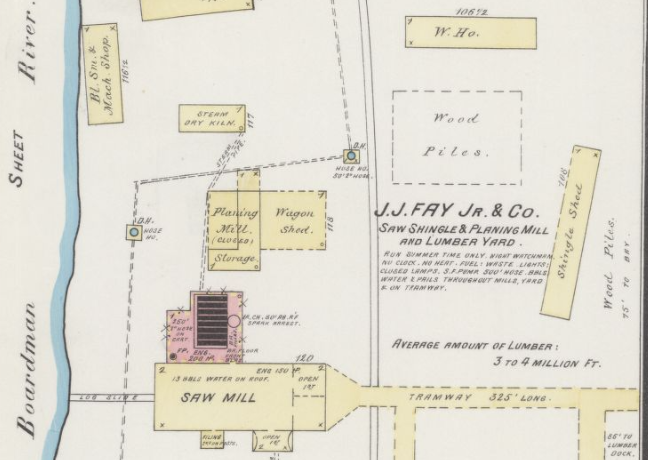
Sanborn Maps, if you are a researcher in the fields of architecture, genealogy, or local history, are invaluable tools. Until recently, Traverse Area District Library only held a copy of the 1929 Traverse City Sanborn, a very small slice of the pie. As of May 25th, the Library of Congress has announced the digitization of their collection of maps, some 25,000, all originally published prior to 1900. Maps will be added monthly until 2020, making for a total of 500,000 Sanborns available in their digital collection. As of this publication, the Traverse City maps for 1884, 1890, 1893, and 1899 are all available.
A Sanborn Map was originally used to provide insurance assessment information to insurance underwriters. Lets say that you owned a wooden warehouse near the pier in Traverse City in 1890. In it is your whole life’s savings, amounting to $100,000 worth of product to ship out… and that product is quite flammable. You would want to insure it, right? But, there are no local insurance companies, and no insurance agent is traveling to so far a place as Traverse City for several months.
 So, how can a company assess your property correctly and insure it for the amount you need? The company would rely on information found in the Sanborn Maps. The Sanborn would reveal where your property was within the city, what type of building it was, its composition, and size. They could also look at your neighbors as well. While the Sanborn might not say what is in each building, knowing who your neighbors were (a gas works, other warehouses, residences), would help the insurance agent make a quality guess on what to appraise your property at… and how risky you’re living!
So, how can a company assess your property correctly and insure it for the amount you need? The company would rely on information found in the Sanborn Maps. The Sanborn would reveal where your property was within the city, what type of building it was, its composition, and size. They could also look at your neighbors as well. While the Sanborn might not say what is in each building, knowing who your neighbors were (a gas works, other warehouses, residences), would help the insurance agent make a quality guess on what to appraise your property at… and how risky you’re living!
How is this information useful for researchers today? Once you know how to read a Sanborn, the world of the past comes alive. Color coding and other indicators found on these maps tells the story of a town. When you boil down all the information, the Sanborn tells you one thing, which can be used for a myriad of uses: How did a city grow, both physically and financially?
did a city grow, both physically and financially?
How does a map answer that type of question? Look to our previous example of 1890s Traverse City. From the Sanborn, we can tell that the city had a significant collection of warehouse buildings near the waterfront, indicating that it was a port city that relied on trade. The large swaths of the city colored in red indicates the predominance of brick-built structures, indicating a lot of sustained growth in the area. How fun would it be to compare the same area, year after year, through the Sanborns? Get the whole family together for that kind of fun!
In addition to these sweeping generalizations, you can also use them to find the businesses owned by your ancestors. As you can guess, there are a number of businesses owned by persons with Bohemian (or Czechoslovakian) names near Randolph and Second Streets. So, even if your family did not own a business, this could be a clue that you should be looking in the general vicinity for your family, if they are of Bohemian descent.
 Another hidden gem in a Sanborn are the names and widths of streets. For any researcher who has had to rely on census records or city directories to try and figure out where a relative lived, especially if street have been renamed or moved since then, this information is no small treat!
Another hidden gem in a Sanborn are the names and widths of streets. For any researcher who has had to rely on census records or city directories to try and figure out where a relative lived, especially if street have been renamed or moved since then, this information is no small treat!
Before now, these maps were only available by traveling great distances to larger libraries, or by paying for very pricy access online through private companies. Every day, your library (whether here in Traverse City or the Library of Congress), is hard at work getting the information you need, in a way that you prefer. We live in amazing times!
Amy Barritt is co-editor of Grand Traverse Journal.


Update: As of 2020 the Library of Congress has also released Traverse City Sanborn maps for 1904, 1910, & 1920.